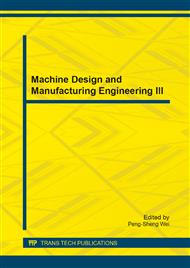[1]
M. Denny and A. McFadzean: Engineering Animals, Harvard Univ. Press, (2011), pp.2-4.
Google Scholar
[2]
V. B. Sukhanov, General System of Symmetrical Locomotion of Terrestrial Vertebrates and Some Features of Movement of Lower Tertapods, Academy of Sciences, USSR(1968), pp.10-11, 75.
Google Scholar
[3]
T. M. Giffin, R. Kram, S. J. Wickler, and D. F. Hoyt, Biomechanical and energetic determinants, of the walk-trot transition in horses, Journal of Exp. Biology, Vol. 207( 2004), pp.4215-4223.
DOI: 10.1242/jeb.01277
Google Scholar
[4]
R. M. Alexander and A. S. Jay, Estimates of Energy Cost for Quadrupedal Running Gaits, J. of Zoology (1980), pp.153-170.
Google Scholar
[5]
R. D. McGhee and G. I. Iswandhi, Adaptive Locomotion of a Multilegged Robot over Rough Terrain, IEEE Trans. on Systems, Man, and Cybernetics, Vol. SMC-9, No. 4(1979), pp.176-182.
DOI: 10.1109/tsmc.1979.4310180
Google Scholar
[6]
B. S. Lin and S. M. Song, Dynamic Modeling, Stability and Energy Efficiency of a Quadrupedal Walking Machine, IEEE Int. Conf. on Robotics and Automation(1993), pp.367-373.
DOI: 10.1109/robot.1993.292201
Google Scholar
[7]
C. D. Zhang and S. M. Song, Stability Analysis of Wave Crab Gaits of a Quadruped, J. of Robotic Systems, Vol. 7(2)(1990), pp.243-276.
DOI: 10.1002/rob.4620070208
Google Scholar
[8]
M.S. Fisher, Walking, Climbing and Reaching: News on Kinematics and Dynamics and Questions about the Level of Control, 4'th Int'l Sym. on Adaptive Motion of Animals and Machines, CWRU, Cleveland, Ohio, June 1-6 (2008).
Google Scholar
[9]
N. Ogihara, S. Aoi, Y. Sugimoto, M. Nakatsukasa and K. Tsuchiya, Synthetic study of quadrupedal/bipedal locomotion in the Japanese monkey, 4'th Int'l Sym. on Adaptive Motion of Animals and Machines, CWRU, Cleveland, Ohio, June 1-6(2008).
Google Scholar
[10]
M. Brady, Planning and Control, Robot Motion, The MIT Press, (1982).
Google Scholar
[11]
F. P. Johnston and E. R. Johnston, Vector Mechanics for Engineers, 4th Ed., McGraw Hill, NY, (1984).
Google Scholar
[12]
S. H. Park, Dynamic Modeling and Link Mechanism of Four-Legged Mobile Robot, Ph. D Dissertation, Univ. of Alabama, Tuscaloosa, (1993).
Google Scholar
[13]
G. Gabrille and T. H. Von Karman, What price Speed, Mechanical Engineering, Vol. 72, No. 10(1950), pp.775-781.
Google Scholar


